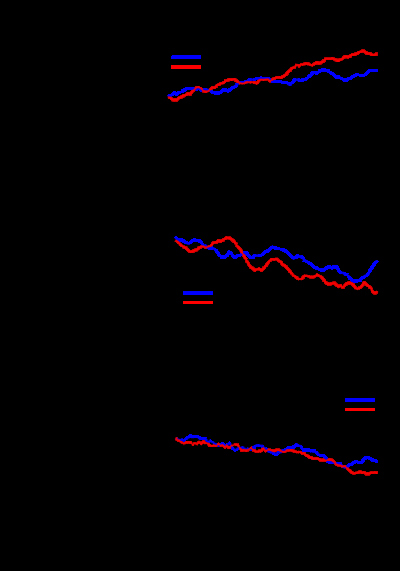Page path:
- Home
- Research
- Ocean and Climate
- Projects & Collaborative Groups
- RACE
- Theme 3
- WP 3.2: Climate changes on the Northwest European Shelf
WP 3.2: Climate changes on the Northwest European Shelf
PIs:
Uwe Mikolajewicz, MPI for Meteorology, Hamburg, uwe.mikolajewicz(at)mpimet.mpg.de
Birgit Klein, BSH, Hamburg, birgit.klein(at)bsh.de
Team:
Moritz Mathis, MPI for Meteorology, Hamburg
Nikesh Narayan, BSH, Hamburg
Holger Klein, BSH, Hamburg
Uwe Mikolajewicz, MPI for Meteorology, Hamburg, uwe.mikolajewicz(at)mpimet.mpg.de
Birgit Klein, BSH, Hamburg, birgit.klein(at)bsh.de
Team:
Moritz Mathis, MPI for Meteorology, Hamburg
Nikesh Narayan, BSH, Hamburg
Holger Klein, BSH, Hamburg

Fig. 1: Annual mean sea surface temperature (top panel), salinity (middle panel), and primary production (bottom panel) in the North Sea, simulated by a regionally coupled climate system model. Preindustrial control run (black dashed), historical run (black), IPCC AR5 scenario RCP4.5 (blue), IPCC AR5 scenario RCP8.5 (red).
The scientific goal of this work package is the estimation of regional climate change in the Northwest European Shelf (NWES), in particular the North Sea, and its dependence on changes in the regional circulation of the North Atlantic. Emphasis is laid on the transition region between the open North Atlantic and the northern North Sea, where exchange processes strongly influence the North Sea physical and biogeochemical conditions.
Results from the preceding project phase suggest distinct water temperature, salinity, and biological primary production changes in the North Sea for the 21. century (Fig. 1). However, comparable studies by other institutions show different changes for salinity and primary production. Our results from a regionally coupled climate system model indicate that a large part of these uncertainties can be attributed to the pronounced multi-decadal variability of the North Atlantic water masses flowing into the NWES.
In the current project phase, influences of anthropogenic climate change and natural variability in the region of the NWES are further investigated by means of ensemble simulations with the same climate system model. In our analyses, we focus on potential circulation changes in the eastern North Atlantic and their interaction with the NWES, in particular the North Sea, and resulting changes in the physical and biogeochemical conditions, including the statistics of extreme events.
Results from the preceding project phase suggest distinct water temperature, salinity, and biological primary production changes in the North Sea for the 21. century (Fig. 1). However, comparable studies by other institutions show different changes for salinity and primary production. Our results from a regionally coupled climate system model indicate that a large part of these uncertainties can be attributed to the pronounced multi-decadal variability of the North Atlantic water masses flowing into the NWES.
In the current project phase, influences of anthropogenic climate change and natural variability in the region of the NWES are further investigated by means of ensemble simulations with the same climate system model. In our analyses, we focus on potential circulation changes in the eastern North Atlantic and their interaction with the NWES, in particular the North Sea, and resulting changes in the physical and biogeochemical conditions, including the statistics of extreme events.


